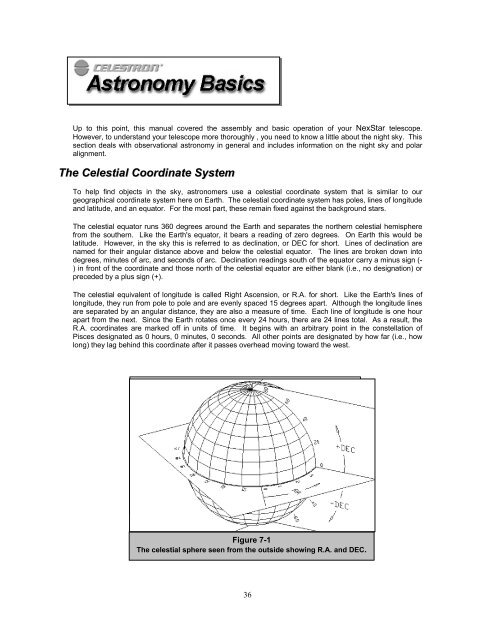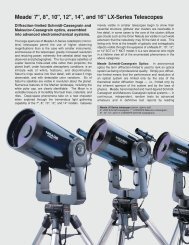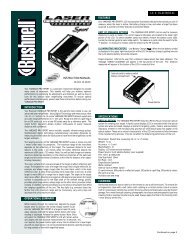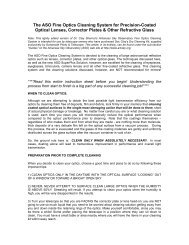INSTRUCTION MANUAL
INSTRUCTION MANUAL
INSTRUCTION MANUAL
Create successful ePaper yourself
Turn your PDF publications into a flip-book with our unique Google optimized e-Paper software.
Up to this point, this manual covered the assembly and basic operation of your NexStar telescope.<br />
However, to understand your telescope more thoroughly , you need to know a little about the night sky. This<br />
section deals with observational astronomy in general and includes information on the night sky and polar<br />
alignment.<br />
The Celestial Coordinate System<br />
To help find objects in the sky, astronomers use a celestial coordinate system that is similar to our<br />
geographical coordinate system here on Earth. The celestial coordinate system has poles, lines of longitude<br />
and latitude, and an equator. For the most part, these remain fixed against the background stars.<br />
The celestial equator runs 360 degrees around the Earth and separates the northern celestial hemisphere<br />
from the southern. Like the Earth's equator, it bears a reading of zero degrees. On Earth this would be<br />
latitude. However, in the sky this is referred to as declination, or DEC for short. Lines of declination are<br />
named for their angular distance above and below the celestial equator. The lines are broken down into<br />
degrees, minutes of arc, and seconds of arc. Declination readings south of the equator carry a minus sign (-<br />
) in front of the coordinate and those north of the celestial equator are either blank (i.e., no designation) or<br />
preceded by a plus sign (+).<br />
The celestial equivalent of longitude is called Right Ascension, or R.A. for short. Like the Earth's lines of<br />
longitude, they run from pole to pole and are evenly spaced 15 degrees apart. Although the longitude lines<br />
are separated by an angular distance, they are also a measure of time. Each line of longitude is one hour<br />
apart from the next. Since the Earth rotates once every 24 hours, there are 24 lines total. As a result, the<br />
R.A. coordinates are marked off in units of time. It begins with an arbitrary point in the constellation of<br />
Pisces designated as 0 hours, 0 minutes, 0 seconds. All other points are designated by how far (i.e., how<br />
long) they lag behind this coordinate after it passes overhead moving toward the west.<br />
Figure 7-1<br />
The celestial sphere seen from the outside showing R.A. and DEC.<br />
36
















